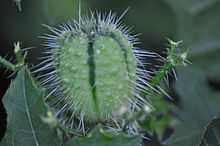Cnidoscolus texanus
| Cnidoscolus texanus | |
|---|---|
 | |
| Scientific classification | |
| Kingdom: | Plantae |
| (unranked): | Angiosperms |
| (unranked): | Eudicots |
| (unranked): | Rosids |
| Order: | Malpighiales |
| Family: | Euphorbiaceae |
| Genus: | Cnidoscolus |
| Species: | C. texanus |
| Binomial name | |
| Cnidoscolus texanus (Müll.Arg.) Small | |
| Synonyms | |
| |
Cnidoscolus texanus, commonly known as Texas Bullnettle,[1] Treadsoftly, and Mala Mujer, is a perennial herb covered with stinging hairs, native to the U.S. States of Texas, Arkansas, Kansas, Louisiana, and Oklahoma.[2] It is also native to the northern Mexican state Tamaulipas.[3] It is an herbaceous flowering plant that grows between 30–80 cm (11.8–31.5 in) tall and as much as 1 m (3.3 ft) across.[4]
Cnidoscolus texanus has white flowers and blooms all throughout the year. The main stem, branches, and leaves are all covered with hispid or glass-like bristly hairs that release an allergenic toxin upon contact.
It is a drought-tolerant plant, therefore making it a superb choice for xeriscaping. This plant is also attractive to bees and butterflies, among other insects, as well as birds.
Description
Perennial plant with erect, branching stems growing from a thick root stock. It has milky latex and stiff prickly glandular-based hairs. The leaves are simple and are alternately arranged on the stem, and each leaf is deeply cut with 3 to 5 lobes. The flowers are in a few flowered terminal cymose inflorescence. Flowers have five sepals and lack petals, the sepals are lobed, white, fragrant, and covered with hispid hairs. Each flower has 10 connate stamens. The fruits are prickly 3-seeded capsules and the seeds are consumed by Rio Grande Wild Turkeys and Mourning Doves.[5]
It was first described by Johannes Müller Argoviensis in 1865 as Jatropha texana.[3][6] It was then moved to the genus Cnidoscolus in 1903 by John Kunkel Small.[7]
References
- ↑ "USDA GRIN Taxonomy".
- ↑ "Cnidoscolus texanus". Natural Resources Conservation Service PLANTS Database. USDA. Retrieved 18 August 2010.
- ↑ 3.0 3.1 "Cnidoscolus texanus (Müll. Arg.) Small". Germplasm Resources Information Network (GRIN) online database. Retrieved 18 August 2010.
- ↑ Johnston MC, and BH Warnock. 1963. The species of Cnidoscolus and Jatropha (Euphorbiaceae) in far Western Texas. The Southwestern Naturalist, 8(3): 121-126.
- ↑ J. H. Everitt; Dale Lynn Drawe; Robert I. Lonard (February 1999). Field guide to the broad-leaved herbaceous plants of south Texas: used by livestock and wildlife. Texas Tech University Press. pp. 103–. ISBN 978-0-89672-400-6. Retrieved 19 August 2010.
- ↑ International Organization for Plant Information (IOPI). "Plant Name Search Results" (HTML). International Plant Names Index. Retrieved 18 August 2010.
- ↑ International Organization for Plant Information (IOPI). "Plant Name Search Results" (HTML). International Plant Names Index. Retrieved 18 August 2010.